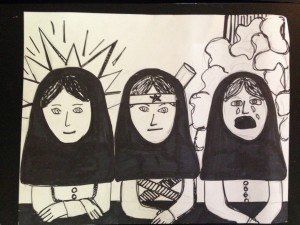Week 12

When reading Persepolis, I was struck by the effect the hijab had on the girls in Iran. My drawing takes inspiration from the first page where all the girls in the class are lined up next to each other to emphasize the lack of individuality they experience when forced to wear the hijab at school. But instead of the many different girls in the class, I wanted to emphasize the different stages and different personas that Satrapi goes through herself throughout the book. The first persona on the left is the that of the prophet. “At the age of six I was already sure I was the last prophet. This was a few years before the revolution”(6). Even though she would not be wearing the hijab at this point in her life because the revolution had not happened yet, I wanted to show the stifling of the personas as a result of head scarf. The rays above her head and the serene expression are meant to represent the light shining out from within her, potentially the Nur Mohammad. This is how she is represented in the graphic novel. To me, this was representative of her childhood innocence before the revolution and before her country got torn up by the Iran/Iraq War.
The second persona is that of a militant or when Satrapi was behind the revolution. In one part of the novel, she is chanting “down with the King” and is wearing ammunition across her chest and has the gun strapped to her back. This is where the image is pulled from but for large parts of the novel, she is supportive of the revolution and the changes that are supposed to come about because of the revolution. This then wraps back around near the end of the novel when she keeps fighting the status quo, it is just a different status quo at is point. She yells at her teachers and acts out in school.
The last persona is one of pain and sorrow. The image is pulled from when the Guardians of the Revolution stopped her for not being properly dressed and she got away. But it is also representative of all the pain she is going through while living in Iran at this point. The pain from the hospital where they would not transfer her relative. The pain from when Neda Baba-levy was killed and Satrapi found her bracelet still attached to the arm.
But on first glance, they do not look all that different because they are all wearing the hijab. These are drastically different stages of Satrapi’s life where she is feeling and doing very different things but the hijab smooths those differences out.